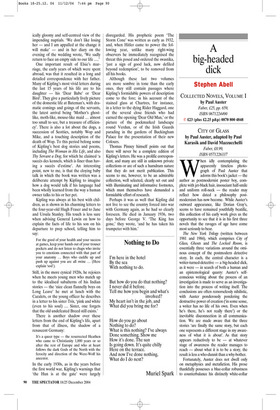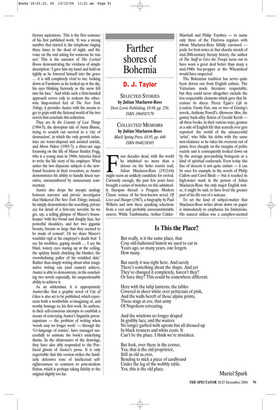A big-headed dick
Stephen Abell
COLLECTED NOVELS, VOLUME I by Paul Auster Faber, £25, pp. 659, ISBN 0671224490 ✆ £23 (plus £2.25 p&p) 0870 800 4848 CITY OF GLASS by Paul Auster, adapted by Paul Karasik and David Mazzucchelli Faber, £8.99, ISBN 0571226337 When idly contemplating the apparently timeless photograph of Paul Auster that adorns this book’s jacket — the author as postmodernist poster boy, complete with jet-black hair, insouciant half-smile and uniform roll-neck — the reader may reflect how dated a philosophy postmodernism has now become. While Auster’s outward appearance, like Dorian Gray’s, seems to have remained youthfully beatific, this collection of his early work gives us the opportunity to see that it is in his first three novels that the ravages of age have come most seriously to bear.
The New York Trilogy (written between 1981 and 1984), which comprises City of Glass, Ghosts and The Locked Room, is essentially three variations around the ominous concept of the postmodern detective story. In each, the central character is a writer-turned-detective — a big-headed dick, as it were — in search of both a human and an epistemological quarry: Auster’s selfconscious writing about the process of an investigation is made to serve as an investigation into the process of writing itself. The conclusions are often remorselessly nihilistic, with Auster ponderously pondering the destructive power of creation (‘in some sense, a writer has no life of his own. Even when he’s there, he’s not really there’) or the inevitable disconnection in all communication. We are made aware that the three stories ‘are finally the same story, but each one represents a different stage in my awareness of what it is about’. As that story appears reductively to be — at whatever stage of awareness the reader manages to reach — about what it is to be a story, the result is less a who-dunnit than a why-bother.
Fortunately, Auster does not dwell only on metaphysics and metafiction. His prose thankfully possesses a blue-collar robustness to counterbalance his distinctly white-collar literary aspirations. This is the first sentence of his first published work: ‘It was a wrong number that started it, the telephone ringing three times in the dead of night, and the voice on the end asking for someone he was not.’ This is the narrator of The Locked Room demonstrating the vividness of simple description: ‘I gave him my hand and held on tightly as he lowered himself into the grave ... it is still completely vivid to me: looking down at Fanshawe as he looked up at the sky, his eyes blinking furiously as the snow fell into his face.’ And while such a firm-handed approach serves only to redeem the otherwise limp-wristed feel of The New York Trilogy, it provides Auster with the means to get to grips with the fictional world of the two novels that conclude this collection.
They are In the Country of Last Things (1984-5), the dystopian tale of Anna Blume, trying to scratch out survival in a ‘city of destruction’, in which the only growth industries are waste-disposal and assisted suicide, and Moon Palace (1985-7), a three-act saga focussing on the life of Marco Stanley Fogg, who is a young man in 1960s America hired to write the life story of his employer. What unites the two disparate subjects is the newfound freedom in their evocation, as Auster demonstrates his ability to handle linear narrative, unencumbered by unnecessary commentary.
Auster also drops the myopic analogy between narrator and private investigator that blinkered The New York Trilogy; instead, he simply demonstrates the searching, private eye for detail of a first-rate novelist. So we get, say, a telling glimpse of Marco’s housekeeper ‘with her broad and doughy face, her powerful shoulders, and her two gigantic breasts, breasts so large that they seemed to be made of cement’. Or we share Marco’s watchful vigil at his employer’s death bed: ‘I see his toothless, gaping mouth ... I see his blind, watery eyes staring up at the ceiling, the spidery hands clutching the blanket, the overwhelming pallor of his wrinkled skin.’ Rather than simply writing about what imaginative writing can (and cannot) achieve, Auster is able to demonstrate, in the concluding two novels especially, his unquestionable ability to achieve it.
As an addendum, it is appropriately Auster-like that a graphic novel of City of Glass is also set to be published, which represents both a worthwhile re-imagining of, and worthy homage to, his first work. Its authors, in their self-conscious attempts to establish a means of conveying Auster’s linguistic preoccupations — the problem of writing when ‘words may no longer work’ — through the ‘Ur-language of comics’, have managed successfully to animate the book’s underlying theme. In the chiaroscuro of the drawings, they have also ably responded to the Poefaced gloom of Auster’s prose. It is only regrettable that this version strikes the familiarly defensive tone of intellectual selfrighteousness so common to post-modern fiction, which is perhaps taking fidelity to the original slightly too far.


















































































 Previous page
Previous page